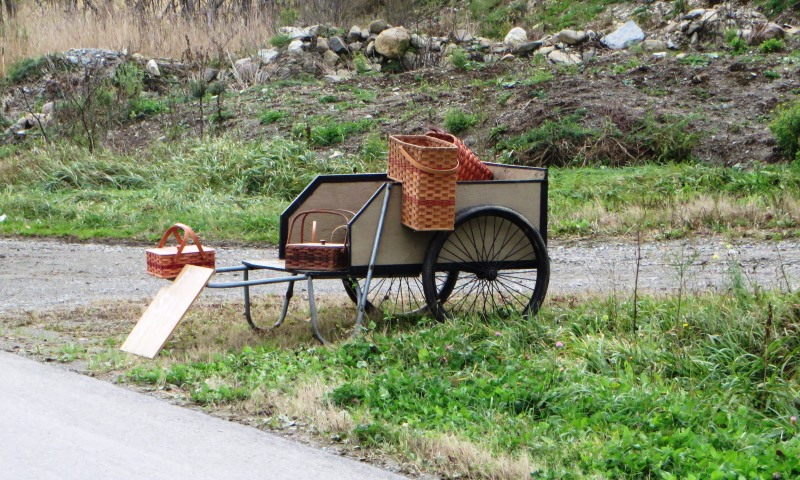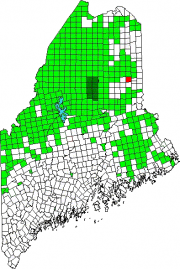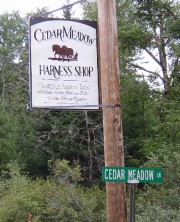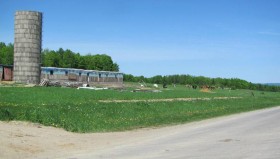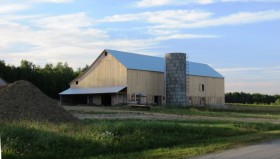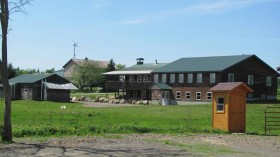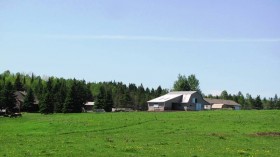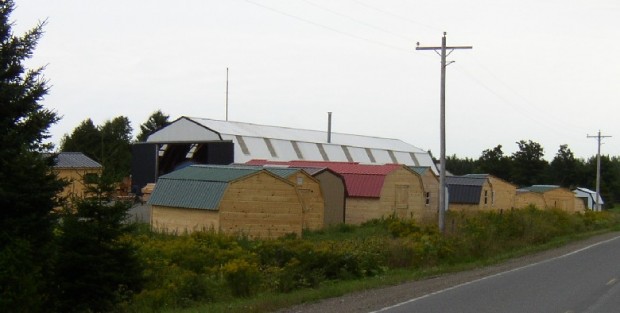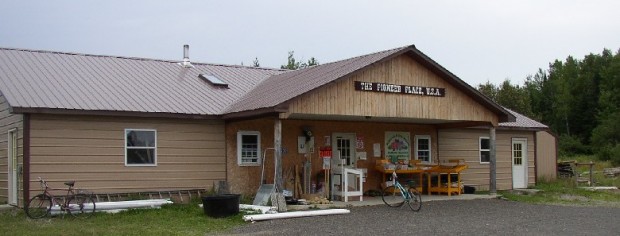Amish Baskets for Sale, Golden Ridge Road, Sherman (2014)

signs: “Wholesome Valley Farms, Certified Organic Vegetables, Fruits, Herbs”; “Rabbits For Sale”; Country Store on County Road (2003)
People of the Old Order Amish community have moved to the town of Smyrna in substantial numbers.
Arriving in 1996, the Amish community had grown from just a few settlers to approximately 80 people in 12 families by 2002. Their shed-building business, Sturdi-Built, has provided a local economic boost to the small town.
By 2014 ten Amish families had settled in East Hodgdon. Nearly twenty Amish families had established farms in the town of Sherman and the surrounding area. In 2012 families arranged a barn raising in Sherman, which resulted in a huge structure raised (see below) in just a few days. Photos location: N45° 56′ 24.4″ W68° 18′ 9.6″ Other communities with Amish residents include Fort Fairfield, Island Falls, Thorndike, Unity and Wales.
According to a Portland Press Herald report in 2002,
While Amish in other parts of the country are known as private people who want nothing to do with the outside world, the Amish in Smyrna have shed that image. They are friendly with any visitor to their community. They do business with non-Amish folks. They enjoy talking with others about their crafts, their stories, their history and – to those who are interested – their spiritual conviction.
“Not every Amish community is like this, and that is why we are here,” said Benuel Esch, who moved to the community a year ago. “We like to share our culture and testify to the rest of society. We like to stay separate from the world, but we intermingle with the outsiders quite a bit. We found that walking the talk is better than talking the walk.”
Amish history is rooted in 17th- century Switzerland, where a group of people called the Anabaptists broke off from the Christian teachings of the time. They believed, in contrast to Roman Catholics, that adults, not children, should be baptized.
The Amish community is relatively self-sufficient. While they pay taxes, their children attend their own school to the eighth grade, after which most join the family farm, or business. They do not use automobiles or electricity, relying on real horse power for transportation and agriculture.
Sturdi-Built, which employs half the men in the community, produces “mini-barns” or storage sheds. Other businesses include an organic vegetable stand, a leather goods and horse harness shop, a small bike repair shop, and a metal shop, which supplies sheets of metal in all colors for roofing and siding to contractors across the state.
“The Pioneer Place, USA” Country Store (2003)
Rustic log beds and tables can be found at the Country Store, which is run by an Amish family. The store sells more to non-Amish customers than to the Amish.
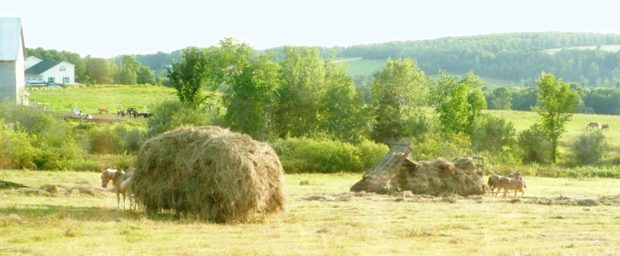
Other Amish families have moved to Unity and Thorndike, David Leaming reported in the Morning Sentinel in 2008. He indicated that the “Amish follow the Anabaptist Christian denomination, best known for simple living, plain dress and resistance to modern conveniences,” according to one of his sources. Leaming quotes him as follows: “Our basic belief is similar to other Christian faiths, that Jesus died for our sins. We will not have electricity in our homes or have telephones, televisions, or use computers . . . .”
Additional resources
Goodman, Giselle. “Old Times, New Attitude.” Portland Press Herald. July 7, 2002. posted on MaineToday.com.
Leaming, David. “Maine’s latest immigrants: Amish.” Morning Sentinel. Waterville, Me. October 22, 2008, p. A1.
“Putting Down Roots: Amish find a home in rugged Maine”, Boston Globe, Sarah Schweitzer, February 2, 2005.
“Profiles in Rural Maine”, allmainematters.com, Ken Anderson, Vol. 1 No. 9, September 2006.
“Fort Fairfield and Easton Welcome Amish Families to Their Communities”, Fort Fairfield Journal, David Deschesne.
“Amish in Fort Fairfield”, March 17, 2011, WLBZ2.
“Amish families reviving farms in Thorndike, Unity”, Bangor Daily News, Walter Griffin, October 23, 2009.
“Living in Unity”, Boston Globe, Sarah Schweitzer, November 29, 2009.
“Maine’s latest immigrants: Amish”, Morning Sentinel, David Leaming, March 17, 2010.
[Some resources are included from http://amishamerica.com/amish-maine/]


